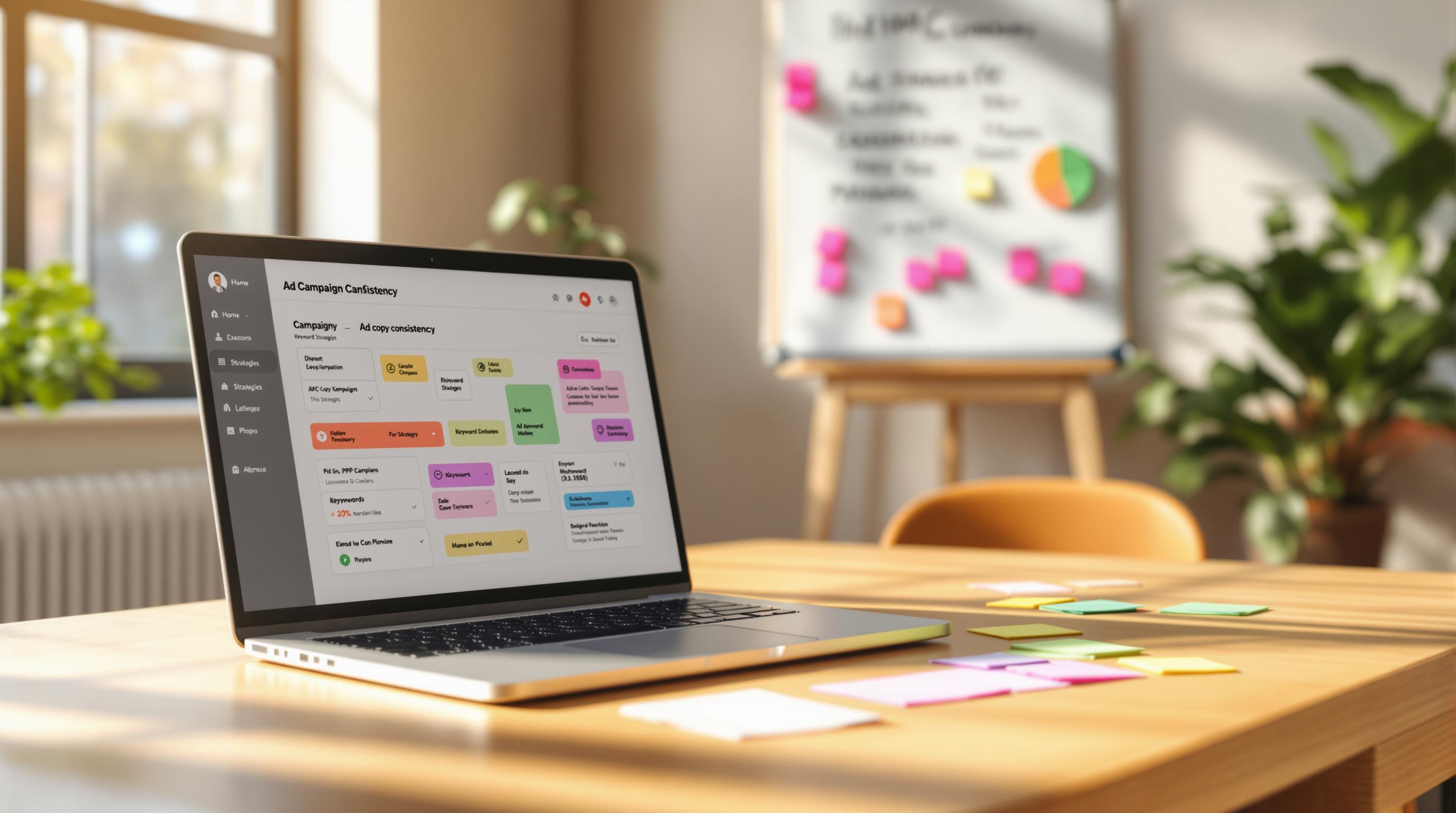A well-organized ad group structure can boost your ad Quality Scores, improve budget efficiency, and create a smoother user experience. Here's what you need to know:
- Group Keywords by Theme: Organize keywords into specific themes like product features, use cases, or brand terms.
- Keep It Simple: Limit each group to 15–20 keywords for easier management and better focus.
- Test Ads: Create at least three ad variations per group to find the most effective messaging.
- Align Landing Pages: Match landing page content with ad group themes for better conversions.
- Monitor Performance: Track metrics like CTR, Quality Score, and ROAS to refine your campaigns.
Ad Group Examples | HOW to Structure Your Google Ads ...
Core Ad Group Structure Guidelines
A well-structured ad group can significantly improve campaign performance. Below are some practical tips to help you create effective ad groups that align with broader campaign strategies.
Group Keywords by Theme
Organizing keywords by theme improves relevance and can lead to better Quality Scores. Focus on creating distinct groups based on:
- Product features (e.g., cushioning, stability, lightweight)
- Use cases (e.g., trail running, marathon training, gym workouts)
- Brand-specific terms (e.g., model names, collections)
Keeping themes narrow allows for more targeted messaging.
Limit the Number of Keywords
After grouping by theme, limit the number of keywords in each ad group. Aim for 15–20 keywords per group. This approach helps maintain focus, makes it easier to identify top-performing keywords, and simplifies bid management.
Test Multiple Ad Variations
With your groups and keywords in place, focus on refining your ads. Testing at least three ad versions per group can help you identify which ones perform best. Here are some tips for ad testing:
- Write different headlines that align with the group’s theme.
- Experiment with various value propositions and calls-to-action.
- Use tools like Creatify to quickly generate ad variations.
- Keep an eye on metrics like click-through rates and conversion rates.
Regularly monitoring these metrics will help you fine-tune your campaigns for better results. For additional resources, check out the Top PPC Marketing Directory.
Advanced Ad Group Methods
Match Landing Pages to Ad Groups
Using landing pages tailored to your ad group's keywords can improve both conversion rates and Quality Scores. Here's how to ensure your landing pages align effectively:
- URL Structure: Create a clear and logical hierarchy that reflects your ad group themes.
- Content Relevance: Match the content on your landing page to the keywords in your ad group.
- Call-to-Action (CTA): Make sure your CTAs fit the intent of the specific ad group.
- Loading Speed: Aim for load times under 3 seconds to minimize bounce rates.
Keep an eye on these elements and adjust as needed to improve campaign results.
Track and Update Performance
Consistent monitoring is key to keeping your ad groups performing well. Focus on these metrics:
- Click-Through Rate (CTR): Regularly check CTR to spot ads that aren't performing well.
- Quality Score: Ensure your keywords, ads, and landing pages remain closely aligned.
- Return on Ad Spend (ROAS): Use this metric to guide your budget allocation decisions.
Set clear goals for each metric based on the data you collect. To take it a step further, consider incorporating dynamic ad content for real-time optimization.
Use Dynamic Ad Content
Dynamic ad content helps keep your ads relevant by automatically adjusting to real-time factors. Here's how to implement it:
Product Feed Integration
Link your product catalog to your ad platform to dynamically include:
- Real-time pricing
- Current inventory levels
- Product names and details
- Special offers
Countdown Timers
Add countdown timers to create urgency for:
- Flash sales
- Limited-time deals
- Seasonal promotions
- Event registration deadlines
Pair dynamic content with AI-driven tools that can automatically adjust bids and content. For more resources on dynamic ad tools, check out the Top PPC Marketing Directory.
sbb-itb-89b8f36
Results of Good Ad Group Structure
Higher Quality Scores
Organizing your ad groups effectively can lead to improved Quality Scores. By aligning your keywords with ad copy, you enhance click-through rates (CTR), relevance, and landing page experience. This results in better ad placements and reduced costs, making your ad spend more efficient.
Smarter Budget Use
A well-thought-out ad group structure helps you focus on the right keywords, reducing wasteful spending. Higher Quality Scores also mean lower conversion costs. Allocating your budget based on performance ensures your campaigns deliver the best results while keeping costs under control.
Better Customer Experience
When your ad content aligns closely with user intent, engagement and conversions naturally improve. By ensuring your keywords, ads, and landing pages work together seamlessly, you create a more satisfying experience for users. This alignment not only drives better results but also strengthens the overall impact of your campaign.
Next Steps
Summary
A well-structured ad group is built on clear themes, smart keyword management, and ongoing adjustments. By organizing keywords effectively, maintaining a manageable group size, and aligning content with user intent, you set the stage for better campaign outcomes. These practices can improve Quality Scores, make your budget work harder, and enhance the overall user experience. To put these strategies into action, consider using specialized PPC tools.
PPC Tools and Resources
To streamline and improve your ad group management, certain tools can automate key tasks and provide valuable insights. The Top PPC Marketing Directory is a great starting point for finding tools that match your campaign goals.
| Tool Category | Purpose | Benefits |
|---|---|---|
| Campaign Management | Simplifies workflows | Automated reporting |
| Bid Management | Optimizes bids | Better ROI |
| Ad Testing | Refines ad creatives | Higher CTR |
| Performance Tracking | Monitors analytics | Real-time insights |
For example, Adverity consolidates PPC data from over 500 sources, making it easier to analyze performance. Meanwhile, Tenscores focuses on improving Quality Scores and cutting costs on Google Ads. As Optmyzr puts it:
"A single platform to audit, optimize, automate, and report on paid media campaigns that grow your business."
Choose tools that match your specific needs and business objectives. Whether you're running campaigns for a small business or a large enterprise, the right tools can make managing and optimizing your ad groups much easier.
FAQs
How does grouping keywords by theme enhance my ad campaign's Quality Score?
Organizing keywords into tightly themed groups helps improve your Quality Score by ensuring your ads are more relevant to user searches. When keywords in an ad group share a common theme, it becomes easier to create highly targeted ad copy that matches search intent.
This alignment between keywords, ad copy, and landing pages not only boosts click-through rates (CTR) but also signals to platforms like Google Ads that your campaign provides value to users. A higher Quality Score can lead to lower cost-per-click (CPC) and better ad placements, ultimately improving your campaign's overall performance.
Why is it important to test different ad variations within an ad group?
Testing multiple ad variations within an ad group is crucial for optimizing your campaign's performance. By experimenting with different headlines, descriptions, and calls-to-action, you can identify which combinations resonate most with your target audience and drive better results.
This process helps improve key metrics like click-through rates (CTR), conversion rates, and overall return on investment (ROI). Additionally, regularly testing and refining your ads ensures they stay relevant and competitive in a constantly evolving market.
How does using dynamic ad content improve the performance of my ad campaigns?
Dynamic ad content can significantly boost your campaign performance by tailoring your ads to match user intent more effectively. By automatically inserting relevant details, such as specific keywords, product names, or locations, dynamic content makes your ads more personalized and engaging for potential customers.
This approach not only increases click-through rates (CTR) but also aligns your ads more closely with search queries, improving ad relevance and Quality Score. As a result, you can optimize your ad spend and drive better results for your campaigns.


